Destination Marketing Strategies and DMOs Role - Jet2holidays Analysis
VerifiedAdded on 2023/06/17
|14
|4571
|52
Report
AI Summary
This report provides an analysis of destination marketing strategies, with a specific focus on Jet2holidays. It explores the principles of marketing planning that support destination marketing, using specific destination examples such as the Royal Museum Greenwich. The report analyzes key elements of various destination marketing campaigns, assessing the success of their objectives, including the Visit Britain GREAT campaign, the Faroe Islands' Sheep View 360, and Carlsbad's Colour campaign. It also reviews digital marketing tools used for promotion, such as content marketing and social media marketing, and examines the role and services of Destination Marketing Organizations (DMOs) in marketing a destination. Finally, the report assesses the challenges faced by DMOs in marketing destinations, providing a comprehensive overview of destination marketing strategies and their effectiveness.
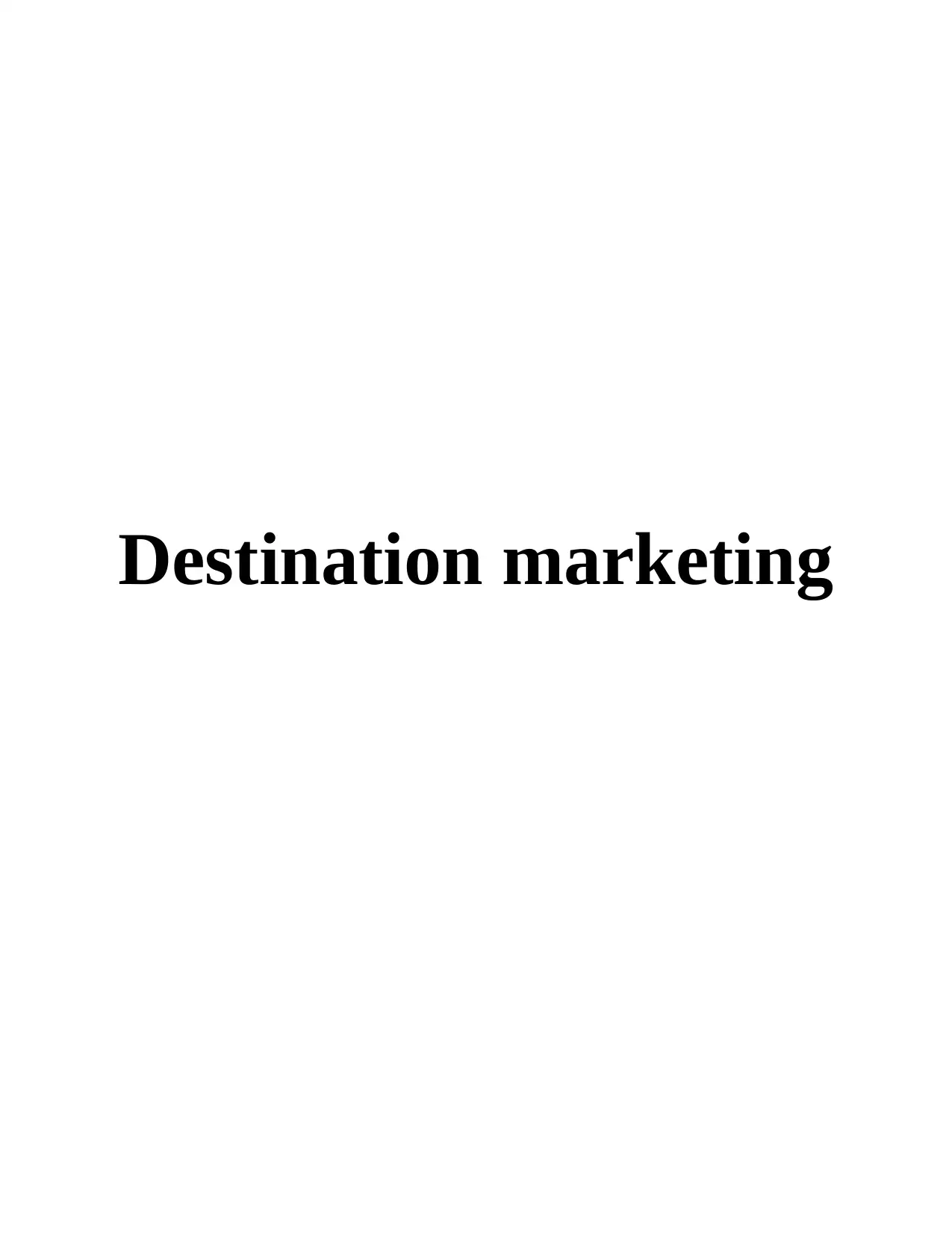
Destination marketing
Paraphrase This Document
Need a fresh take? Get an instant paraphrase of this document with our AI Paraphraser
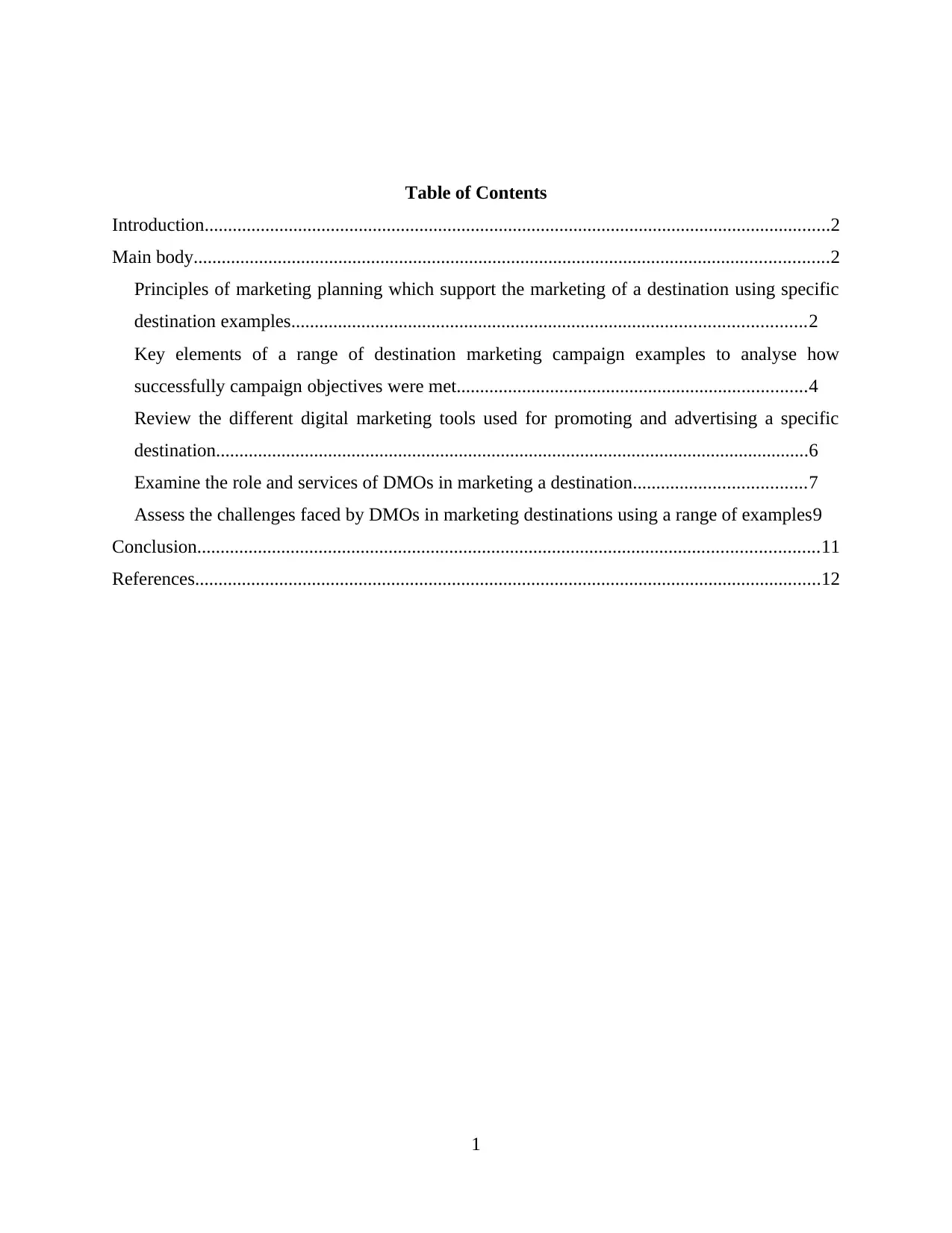
Table of Contents
Introduction......................................................................................................................................2
Main body........................................................................................................................................2
Principles of marketing planning which support the marketing of a destination using specific
destination examples..............................................................................................................2
Key elements of a range of destination marketing campaign examples to analyse how
successfully campaign objectives were met...........................................................................4
Review the different digital marketing tools used for promoting and advertising a specific
destination...............................................................................................................................6
Examine the role and services of DMOs in marketing a destination.....................................7
Assess the challenges faced by DMOs in marketing destinations using a range of examples9
Conclusion.....................................................................................................................................11
References......................................................................................................................................12
1
Introduction......................................................................................................................................2
Main body........................................................................................................................................2
Principles of marketing planning which support the marketing of a destination using specific
destination examples..............................................................................................................2
Key elements of a range of destination marketing campaign examples to analyse how
successfully campaign objectives were met...........................................................................4
Review the different digital marketing tools used for promoting and advertising a specific
destination...............................................................................................................................6
Examine the role and services of DMOs in marketing a destination.....................................7
Assess the challenges faced by DMOs in marketing destinations using a range of examples9
Conclusion.....................................................................................................................................11
References......................................................................................................................................12
1
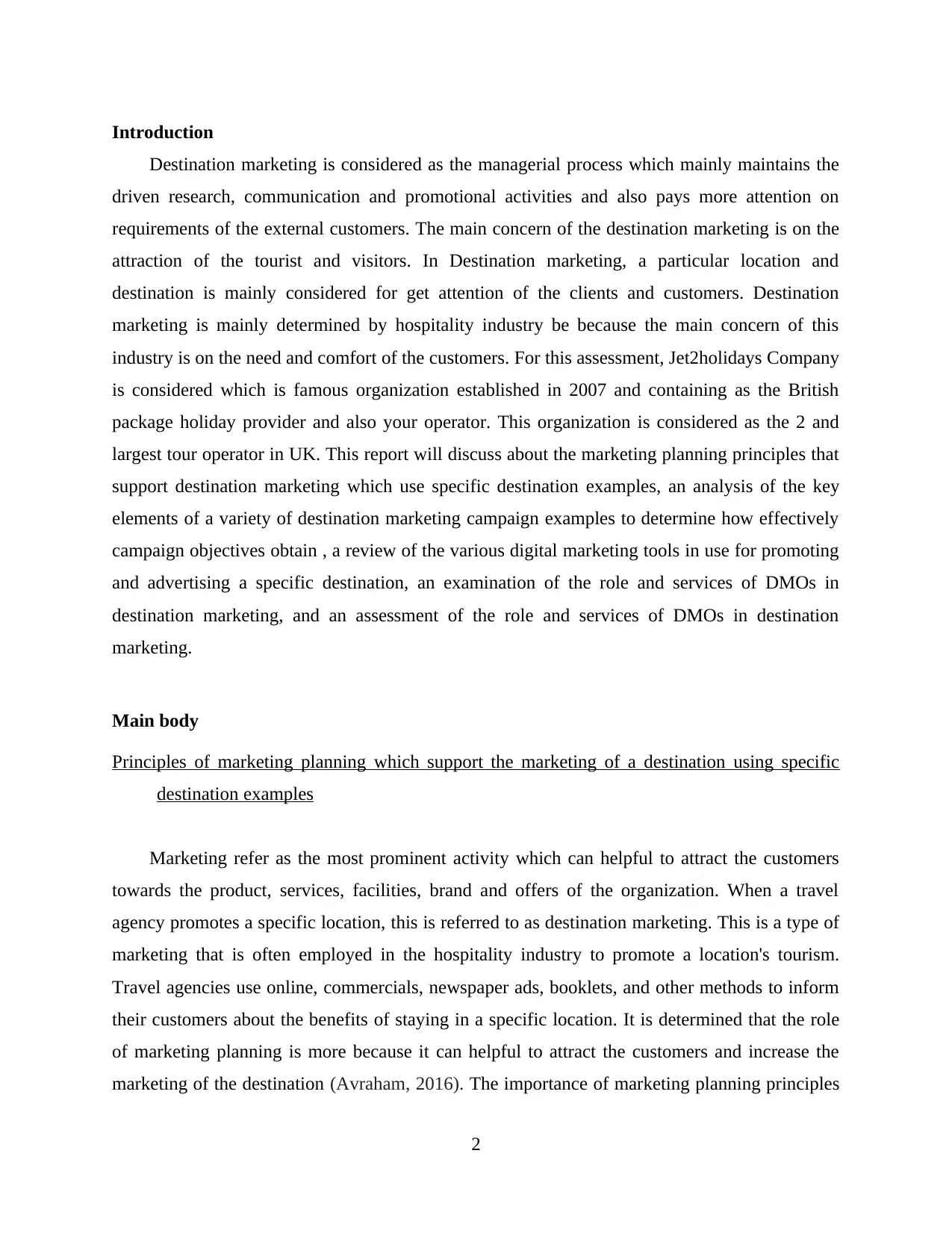
Introduction
Destination marketing is considered as the managerial process which mainly maintains the
driven research, communication and promotional activities and also pays more attention on
requirements of the external customers. The main concern of the destination marketing is on the
attraction of the tourist and visitors. In Destination marketing, a particular location and
destination is mainly considered for get attention of the clients and customers. Destination
marketing is mainly determined by hospitality industry be because the main concern of this
industry is on the need and comfort of the customers. For this assessment, Jet2holidays Company
is considered which is famous organization established in 2007 and containing as the British
package holiday provider and also your operator. This organization is considered as the 2 and
largest tour operator in UK. This report will discuss about the marketing planning principles that
support destination marketing which use specific destination examples, an analysis of the key
elements of a variety of destination marketing campaign examples to determine how effectively
campaign objectives obtain , a review of the various digital marketing tools in use for promoting
and advertising a specific destination, an examination of the role and services of DMOs in
destination marketing, and an assessment of the role and services of DMOs in destination
marketing.
Main body
Principles of marketing planning which support the marketing of a destination using specific
destination examples
Marketing refer as the most prominent activity which can helpful to attract the customers
towards the product, services, facilities, brand and offers of the organization. When a travel
agency promotes a specific location, this is referred to as destination marketing. This is a type of
marketing that is often employed in the hospitality industry to promote a location's tourism.
Travel agencies use online, commercials, newspaper ads, booklets, and other methods to inform
their customers about the benefits of staying in a specific location. It is determined that the role
of marketing planning is more because it can helpful to attract the customers and increase the
marketing of the destination (Avraham, 2016). The importance of marketing planning principles
2
Destination marketing is considered as the managerial process which mainly maintains the
driven research, communication and promotional activities and also pays more attention on
requirements of the external customers. The main concern of the destination marketing is on the
attraction of the tourist and visitors. In Destination marketing, a particular location and
destination is mainly considered for get attention of the clients and customers. Destination
marketing is mainly determined by hospitality industry be because the main concern of this
industry is on the need and comfort of the customers. For this assessment, Jet2holidays Company
is considered which is famous organization established in 2007 and containing as the British
package holiday provider and also your operator. This organization is considered as the 2 and
largest tour operator in UK. This report will discuss about the marketing planning principles that
support destination marketing which use specific destination examples, an analysis of the key
elements of a variety of destination marketing campaign examples to determine how effectively
campaign objectives obtain , a review of the various digital marketing tools in use for promoting
and advertising a specific destination, an examination of the role and services of DMOs in
destination marketing, and an assessment of the role and services of DMOs in destination
marketing.
Main body
Principles of marketing planning which support the marketing of a destination using specific
destination examples
Marketing refer as the most prominent activity which can helpful to attract the customers
towards the product, services, facilities, brand and offers of the organization. When a travel
agency promotes a specific location, this is referred to as destination marketing. This is a type of
marketing that is often employed in the hospitality industry to promote a location's tourism.
Travel agencies use online, commercials, newspaper ads, booklets, and other methods to inform
their customers about the benefits of staying in a specific location. It is determined that the role
of marketing planning is more because it can helpful to attract the customers and increase the
marketing of the destination (Avraham, 2016). The importance of marketing planning principles
2
⊘ This is a preview!⊘
Do you want full access?
Subscribe today to unlock all pages.

Trusted by 1+ million students worldwide
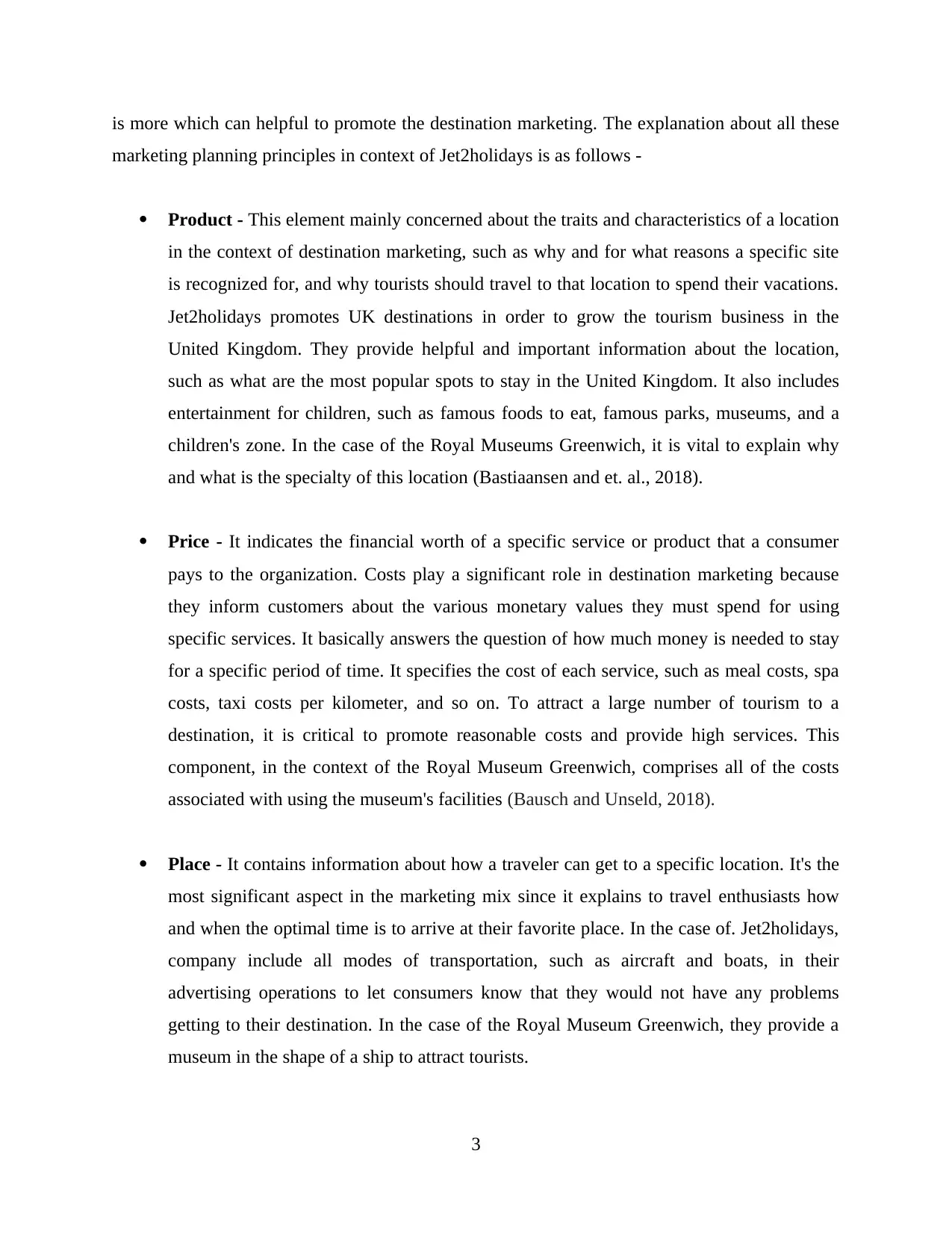
is more which can helpful to promote the destination marketing. The explanation about all these
marketing planning principles in context of Jet2holidays is as follows -
Product - This element mainly concerned about the traits and characteristics of a location
in the context of destination marketing, such as why and for what reasons a specific site
is recognized for, and why tourists should travel to that location to spend their vacations.
Jet2holidays promotes UK destinations in order to grow the tourism business in the
United Kingdom. They provide helpful and important information about the location,
such as what are the most popular spots to stay in the United Kingdom. It also includes
entertainment for children, such as famous foods to eat, famous parks, museums, and a
children's zone. In the case of the Royal Museums Greenwich, it is vital to explain why
and what is the specialty of this location (Bastiaansen and et. al., 2018).
Price - It indicates the financial worth of a specific service or product that a consumer
pays to the organization. Costs play a significant role in destination marketing because
they inform customers about the various monetary values they must spend for using
specific services. It basically answers the question of how much money is needed to stay
for a specific period of time. It specifies the cost of each service, such as meal costs, spa
costs, taxi costs per kilometer, and so on. To attract a large number of tourism to a
destination, it is critical to promote reasonable costs and provide high services. This
component, in the context of the Royal Museum Greenwich, comprises all of the costs
associated with using the museum's facilities (Bausch and Unseld, 2018).
Place - It contains information about how a traveler can get to a specific location. It's the
most significant aspect in the marketing mix since it explains to travel enthusiasts how
and when the optimal time is to arrive at their favorite place. In the case of. Jet2holidays,
company include all modes of transportation, such as aircraft and boats, in their
advertising operations to let consumers know that they would not have any problems
getting to their destination. In the case of the Royal Museum Greenwich, they provide a
museum in the shape of a ship to attract tourists.
3
marketing planning principles in context of Jet2holidays is as follows -
Product - This element mainly concerned about the traits and characteristics of a location
in the context of destination marketing, such as why and for what reasons a specific site
is recognized for, and why tourists should travel to that location to spend their vacations.
Jet2holidays promotes UK destinations in order to grow the tourism business in the
United Kingdom. They provide helpful and important information about the location,
such as what are the most popular spots to stay in the United Kingdom. It also includes
entertainment for children, such as famous foods to eat, famous parks, museums, and a
children's zone. In the case of the Royal Museums Greenwich, it is vital to explain why
and what is the specialty of this location (Bastiaansen and et. al., 2018).
Price - It indicates the financial worth of a specific service or product that a consumer
pays to the organization. Costs play a significant role in destination marketing because
they inform customers about the various monetary values they must spend for using
specific services. It basically answers the question of how much money is needed to stay
for a specific period of time. It specifies the cost of each service, such as meal costs, spa
costs, taxi costs per kilometer, and so on. To attract a large number of tourism to a
destination, it is critical to promote reasonable costs and provide high services. This
component, in the context of the Royal Museum Greenwich, comprises all of the costs
associated with using the museum's facilities (Bausch and Unseld, 2018).
Place - It contains information about how a traveler can get to a specific location. It's the
most significant aspect in the marketing mix since it explains to travel enthusiasts how
and when the optimal time is to arrive at their favorite place. In the case of. Jet2holidays,
company include all modes of transportation, such as aircraft and boats, in their
advertising operations to let consumers know that they would not have any problems
getting to their destination. In the case of the Royal Museum Greenwich, they provide a
museum in the shape of a ship to attract tourists.
3
Paraphrase This Document
Need a fresh take? Get an instant paraphrase of this document with our AI Paraphraser
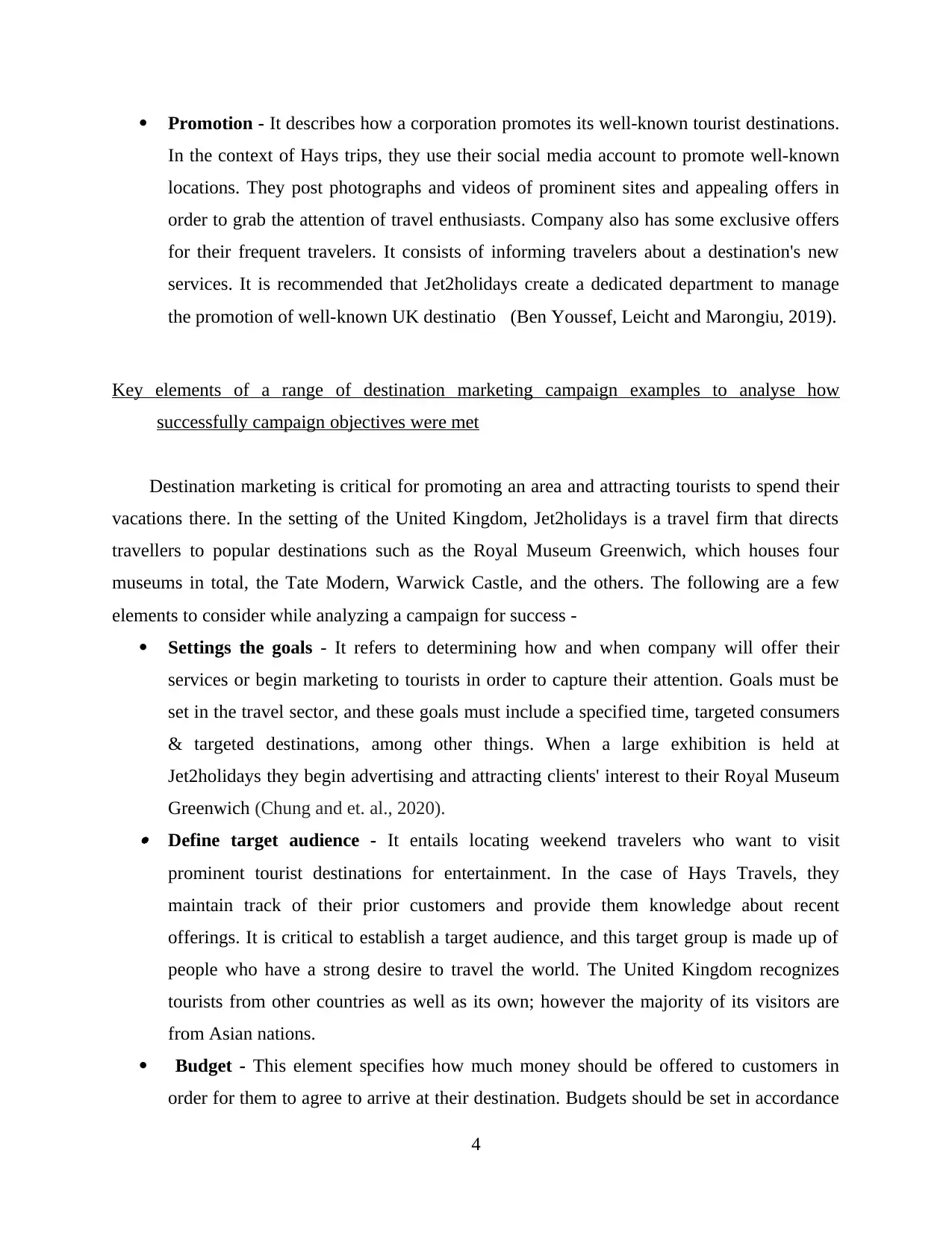
Promotion - It describes how a corporation promotes its well-known tourist destinations.
In the context of Hays trips, they use their social media account to promote well-known
locations. They post photographs and videos of prominent sites and appealing offers in
order to grab the attention of travel enthusiasts. Company also has some exclusive offers
for their frequent travelers. It consists of informing travelers about a destination's new
services. It is recommended that Jet2holidays create a dedicated department to manage
the promotion of well-known UK destinatio (Ben Youssef, Leicht and Marongiu, 2019).
Key elements of a range of destination marketing campaign examples to analyse how
successfully campaign objectives were met
Destination marketing is critical for promoting an area and attracting tourists to spend their
vacations there. In the setting of the United Kingdom, Jet2holidays is a travel firm that directs
travellers to popular destinations such as the Royal Museum Greenwich, which houses four
museums in total, the Tate Modern, Warwick Castle, and the others. The following are a few
elements to consider while analyzing a campaign for success -
Settings the goals - It refers to determining how and when company will offer their
services or begin marketing to tourists in order to capture their attention. Goals must be
set in the travel sector, and these goals must include a specified time, targeted consumers
& targeted destinations, among other things. When a large exhibition is held at
Jet2holidays they begin advertising and attracting clients' interest to their Royal Museum
Greenwich (Chung and et. al., 2020). Define target audience - It entails locating weekend travelers who want to visit
prominent tourist destinations for entertainment. In the case of Hays Travels, they
maintain track of their prior customers and provide them knowledge about recent
offerings. It is critical to establish a target audience, and this target group is made up of
people who have a strong desire to travel the world. The United Kingdom recognizes
tourists from other countries as well as its own; however the majority of its visitors are
from Asian nations.
Budget - This element specifies how much money should be offered to customers in
order for them to agree to arrive at their destination. Budgets should be set in accordance
4
In the context of Hays trips, they use their social media account to promote well-known
locations. They post photographs and videos of prominent sites and appealing offers in
order to grab the attention of travel enthusiasts. Company also has some exclusive offers
for their frequent travelers. It consists of informing travelers about a destination's new
services. It is recommended that Jet2holidays create a dedicated department to manage
the promotion of well-known UK destinatio (Ben Youssef, Leicht and Marongiu, 2019).
Key elements of a range of destination marketing campaign examples to analyse how
successfully campaign objectives were met
Destination marketing is critical for promoting an area and attracting tourists to spend their
vacations there. In the setting of the United Kingdom, Jet2holidays is a travel firm that directs
travellers to popular destinations such as the Royal Museum Greenwich, which houses four
museums in total, the Tate Modern, Warwick Castle, and the others. The following are a few
elements to consider while analyzing a campaign for success -
Settings the goals - It refers to determining how and when company will offer their
services or begin marketing to tourists in order to capture their attention. Goals must be
set in the travel sector, and these goals must include a specified time, targeted consumers
& targeted destinations, among other things. When a large exhibition is held at
Jet2holidays they begin advertising and attracting clients' interest to their Royal Museum
Greenwich (Chung and et. al., 2020). Define target audience - It entails locating weekend travelers who want to visit
prominent tourist destinations for entertainment. In the case of Hays Travels, they
maintain track of their prior customers and provide them knowledge about recent
offerings. It is critical to establish a target audience, and this target group is made up of
people who have a strong desire to travel the world. The United Kingdom recognizes
tourists from other countries as well as its own; however the majority of its visitors are
from Asian nations.
Budget - This element specifies how much money should be offered to customers in
order for them to agree to arrive at their destination. Budgets should be set in accordance
4
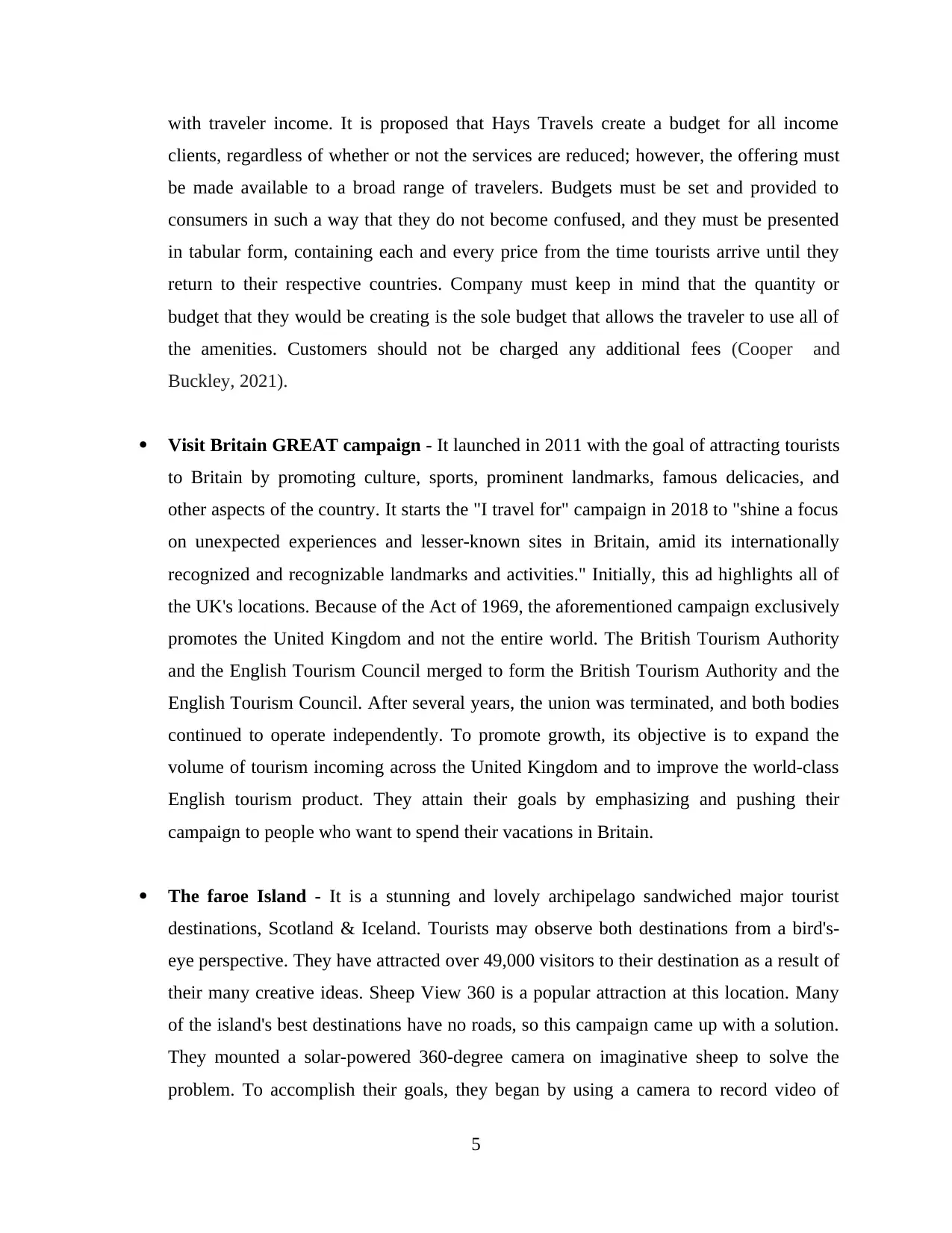
with traveler income. It is proposed that Hays Travels create a budget for all income
clients, regardless of whether or not the services are reduced; however, the offering must
be made available to a broad range of travelers. Budgets must be set and provided to
consumers in such a way that they do not become confused, and they must be presented
in tabular form, containing each and every price from the time tourists arrive until they
return to their respective countries. Company must keep in mind that the quantity or
budget that they would be creating is the sole budget that allows the traveler to use all of
the amenities. Customers should not be charged any additional fees (Cooper and
Buckley, 2021).
Visit Britain GREAT campaign - It launched in 2011 with the goal of attracting tourists
to Britain by promoting culture, sports, prominent landmarks, famous delicacies, and
other aspects of the country. It starts the "I travel for" campaign in 2018 to "shine a focus
on unexpected experiences and lesser-known sites in Britain, amid its internationally
recognized and recognizable landmarks and activities." Initially, this ad highlights all of
the UK's locations. Because of the Act of 1969, the aforementioned campaign exclusively
promotes the United Kingdom and not the entire world. The British Tourism Authority
and the English Tourism Council merged to form the British Tourism Authority and the
English Tourism Council. After several years, the union was terminated, and both bodies
continued to operate independently. To promote growth, its objective is to expand the
volume of tourism incoming across the United Kingdom and to improve the world-class
English tourism product. They attain their goals by emphasizing and pushing their
campaign to people who want to spend their vacations in Britain.
The faroe Island - It is a stunning and lovely archipelago sandwiched major tourist
destinations, Scotland & Iceland. Tourists may observe both destinations from a bird's-
eye perspective. They have attracted over 49,000 visitors to their destination as a result of
their many creative ideas. Sheep View 360 is a popular attraction at this location. Many
of the island's best destinations have no roads, so this campaign came up with a solution.
They mounted a solar-powered 360-degree camera on imaginative sheep to solve the
problem. To accomplish their goals, they began by using a camera to record video of
5
clients, regardless of whether or not the services are reduced; however, the offering must
be made available to a broad range of travelers. Budgets must be set and provided to
consumers in such a way that they do not become confused, and they must be presented
in tabular form, containing each and every price from the time tourists arrive until they
return to their respective countries. Company must keep in mind that the quantity or
budget that they would be creating is the sole budget that allows the traveler to use all of
the amenities. Customers should not be charged any additional fees (Cooper and
Buckley, 2021).
Visit Britain GREAT campaign - It launched in 2011 with the goal of attracting tourists
to Britain by promoting culture, sports, prominent landmarks, famous delicacies, and
other aspects of the country. It starts the "I travel for" campaign in 2018 to "shine a focus
on unexpected experiences and lesser-known sites in Britain, amid its internationally
recognized and recognizable landmarks and activities." Initially, this ad highlights all of
the UK's locations. Because of the Act of 1969, the aforementioned campaign exclusively
promotes the United Kingdom and not the entire world. The British Tourism Authority
and the English Tourism Council merged to form the British Tourism Authority and the
English Tourism Council. After several years, the union was terminated, and both bodies
continued to operate independently. To promote growth, its objective is to expand the
volume of tourism incoming across the United Kingdom and to improve the world-class
English tourism product. They attain their goals by emphasizing and pushing their
campaign to people who want to spend their vacations in Britain.
The faroe Island - It is a stunning and lovely archipelago sandwiched major tourist
destinations, Scotland & Iceland. Tourists may observe both destinations from a bird's-
eye perspective. They have attracted over 49,000 visitors to their destination as a result of
their many creative ideas. Sheep View 360 is a popular attraction at this location. Many
of the island's best destinations have no roads, so this campaign came up with a solution.
They mounted a solar-powered 360-degree camera on imaginative sheep to solve the
problem. To accomplish their goals, they began by using a camera to record video of
5
⊘ This is a preview!⊘
Do you want full access?
Subscribe today to unlock all pages.

Trusted by 1+ million students worldwide
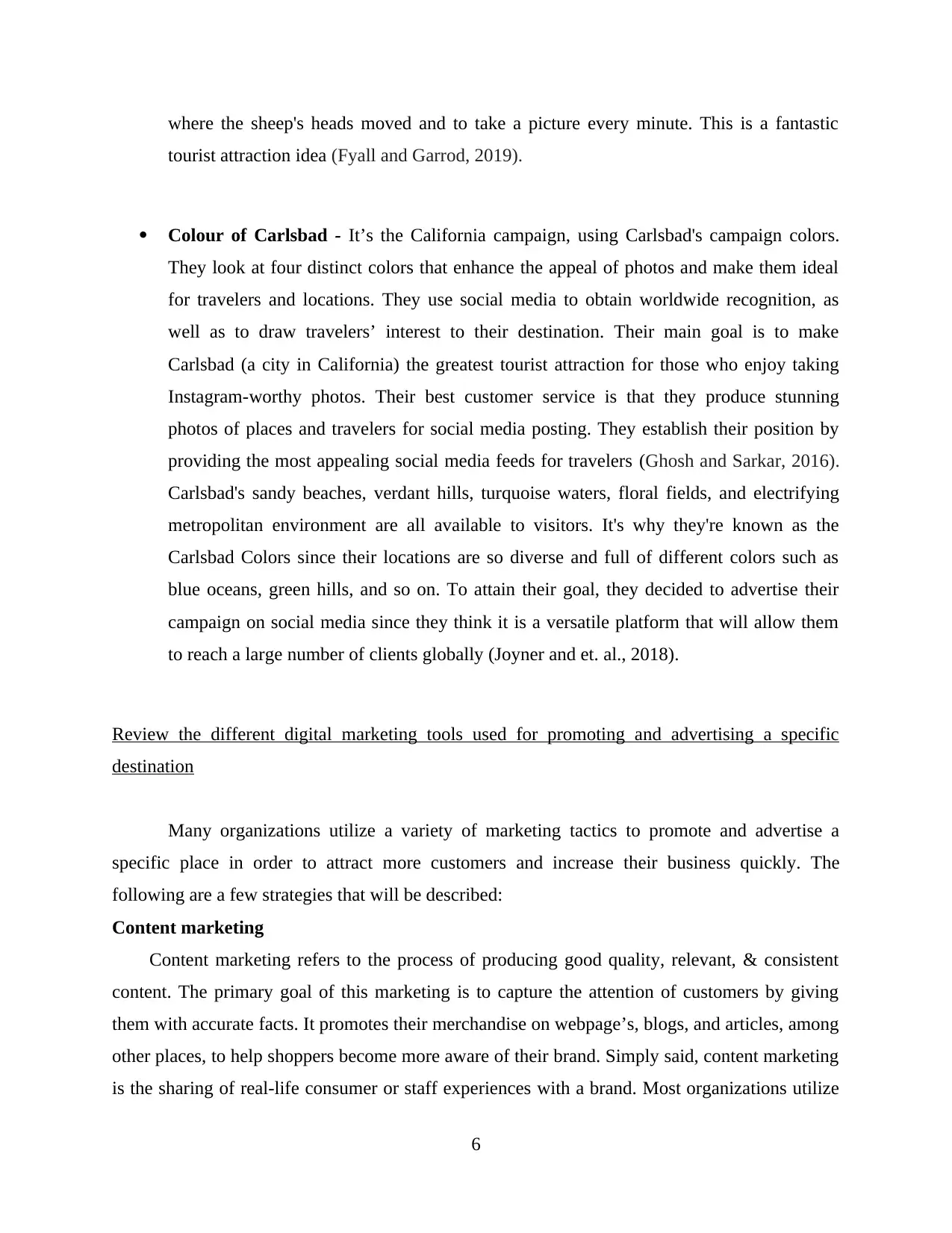
where the sheep's heads moved and to take a picture every minute. This is a fantastic
tourist attraction idea (Fyall and Garrod, 2019).
Colour of Carlsbad - It’s the California campaign, using Carlsbad's campaign colors.
They look at four distinct colors that enhance the appeal of photos and make them ideal
for travelers and locations. They use social media to obtain worldwide recognition, as
well as to draw travelers’ interest to their destination. Their main goal is to make
Carlsbad (a city in California) the greatest tourist attraction for those who enjoy taking
Instagram-worthy photos. Their best customer service is that they produce stunning
photos of places and travelers for social media posting. They establish their position by
providing the most appealing social media feeds for travelers (Ghosh and Sarkar, 2016).
Carlsbad's sandy beaches, verdant hills, turquoise waters, floral fields, and electrifying
metropolitan environment are all available to visitors. It's why they're known as the
Carlsbad Colors since their locations are so diverse and full of different colors such as
blue oceans, green hills, and so on. To attain their goal, they decided to advertise their
campaign on social media since they think it is a versatile platform that will allow them
to reach a large number of clients globally (Joyner and et. al., 2018).
Review the different digital marketing tools used for promoting and advertising a specific
destination
Many organizations utilize a variety of marketing tactics to promote and advertise a
specific place in order to attract more customers and increase their business quickly. The
following are a few strategies that will be described:
Content marketing
Content marketing refers to the process of producing good quality, relevant, & consistent
content. The primary goal of this marketing is to capture the attention of customers by giving
them with accurate facts. It promotes their merchandise on webpage’s, blogs, and articles, among
other places, to help shoppers become more aware of their brand. Simply said, content marketing
is the sharing of real-life consumer or staff experiences with a brand. Most organizations utilize
6
tourist attraction idea (Fyall and Garrod, 2019).
Colour of Carlsbad - It’s the California campaign, using Carlsbad's campaign colors.
They look at four distinct colors that enhance the appeal of photos and make them ideal
for travelers and locations. They use social media to obtain worldwide recognition, as
well as to draw travelers’ interest to their destination. Their main goal is to make
Carlsbad (a city in California) the greatest tourist attraction for those who enjoy taking
Instagram-worthy photos. Their best customer service is that they produce stunning
photos of places and travelers for social media posting. They establish their position by
providing the most appealing social media feeds for travelers (Ghosh and Sarkar, 2016).
Carlsbad's sandy beaches, verdant hills, turquoise waters, floral fields, and electrifying
metropolitan environment are all available to visitors. It's why they're known as the
Carlsbad Colors since their locations are so diverse and full of different colors such as
blue oceans, green hills, and so on. To attain their goal, they decided to advertise their
campaign on social media since they think it is a versatile platform that will allow them
to reach a large number of clients globally (Joyner and et. al., 2018).
Review the different digital marketing tools used for promoting and advertising a specific
destination
Many organizations utilize a variety of marketing tactics to promote and advertise a
specific place in order to attract more customers and increase their business quickly. The
following are a few strategies that will be described:
Content marketing
Content marketing refers to the process of producing good quality, relevant, & consistent
content. The primary goal of this marketing is to capture the attention of customers by giving
them with accurate facts. It promotes their merchandise on webpage’s, blogs, and articles, among
other places, to help shoppers become more aware of their brand. Simply said, content marketing
is the sharing of real-life consumer or staff experiences with a brand. Most organizations utilize
6
Paraphrase This Document
Need a fresh take? Get an instant paraphrase of this document with our AI Paraphraser
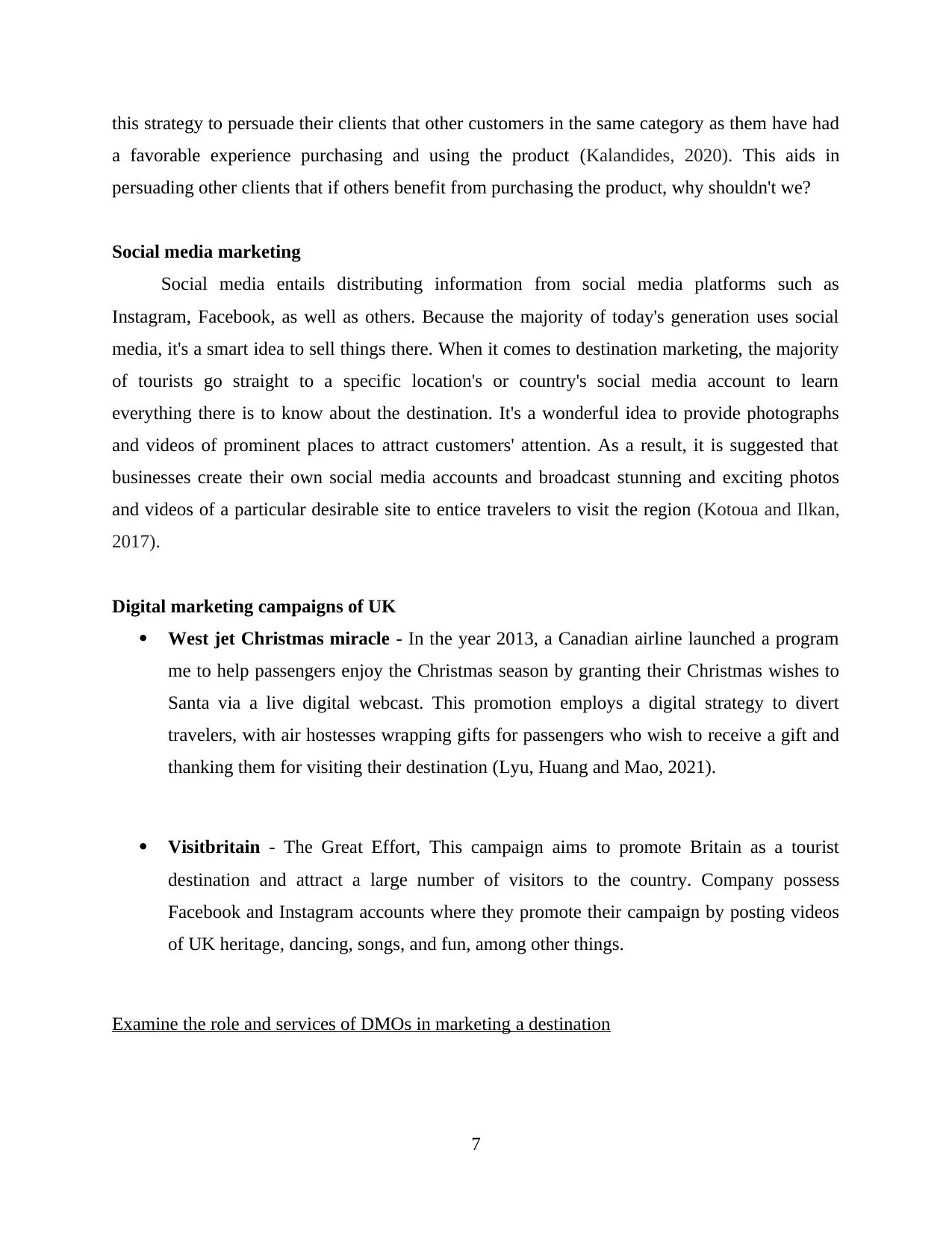
this strategy to persuade their clients that other customers in the same category as them have had
a favorable experience purchasing and using the product (Kalandides, 2020). This aids in
persuading other clients that if others benefit from purchasing the product, why shouldn't we?
Social media marketing
Social media entails distributing information from social media platforms such as
Instagram, Facebook, as well as others. Because the majority of today's generation uses social
media, it's a smart idea to sell things there. When it comes to destination marketing, the majority
of tourists go straight to a specific location's or country's social media account to learn
everything there is to know about the destination. It's a wonderful idea to provide photographs
and videos of prominent places to attract customers' attention. As a result, it is suggested that
businesses create their own social media accounts and broadcast stunning and exciting photos
and videos of a particular desirable site to entice travelers to visit the region (Kotoua and Ilkan,
2017).
Digital marketing campaigns of UK
West jet Christmas miracle - In the year 2013, a Canadian airline launched a program
me to help passengers enjoy the Christmas season by granting their Christmas wishes to
Santa via a live digital webcast. This promotion employs a digital strategy to divert
travelers, with air hostesses wrapping gifts for passengers who wish to receive a gift and
thanking them for visiting their destination (Lyu, Huang and Mao, 2021).
Visitbritain - The Great Effort, This campaign aims to promote Britain as a tourist
destination and attract a large number of visitors to the country. Company possess
Facebook and Instagram accounts where they promote their campaign by posting videos
of UK heritage, dancing, songs, and fun, among other things.
Examine the role and services of DMOs in marketing a destination
7
a favorable experience purchasing and using the product (Kalandides, 2020). This aids in
persuading other clients that if others benefit from purchasing the product, why shouldn't we?
Social media marketing
Social media entails distributing information from social media platforms such as
Instagram, Facebook, as well as others. Because the majority of today's generation uses social
media, it's a smart idea to sell things there. When it comes to destination marketing, the majority
of tourists go straight to a specific location's or country's social media account to learn
everything there is to know about the destination. It's a wonderful idea to provide photographs
and videos of prominent places to attract customers' attention. As a result, it is suggested that
businesses create their own social media accounts and broadcast stunning and exciting photos
and videos of a particular desirable site to entice travelers to visit the region (Kotoua and Ilkan,
2017).
Digital marketing campaigns of UK
West jet Christmas miracle - In the year 2013, a Canadian airline launched a program
me to help passengers enjoy the Christmas season by granting their Christmas wishes to
Santa via a live digital webcast. This promotion employs a digital strategy to divert
travelers, with air hostesses wrapping gifts for passengers who wish to receive a gift and
thanking them for visiting their destination (Lyu, Huang and Mao, 2021).
Visitbritain - The Great Effort, This campaign aims to promote Britain as a tourist
destination and attract a large number of visitors to the country. Company possess
Facebook and Instagram accounts where they promote their campaign by posting videos
of UK heritage, dancing, songs, and fun, among other things.
Examine the role and services of DMOs in marketing a destination
7
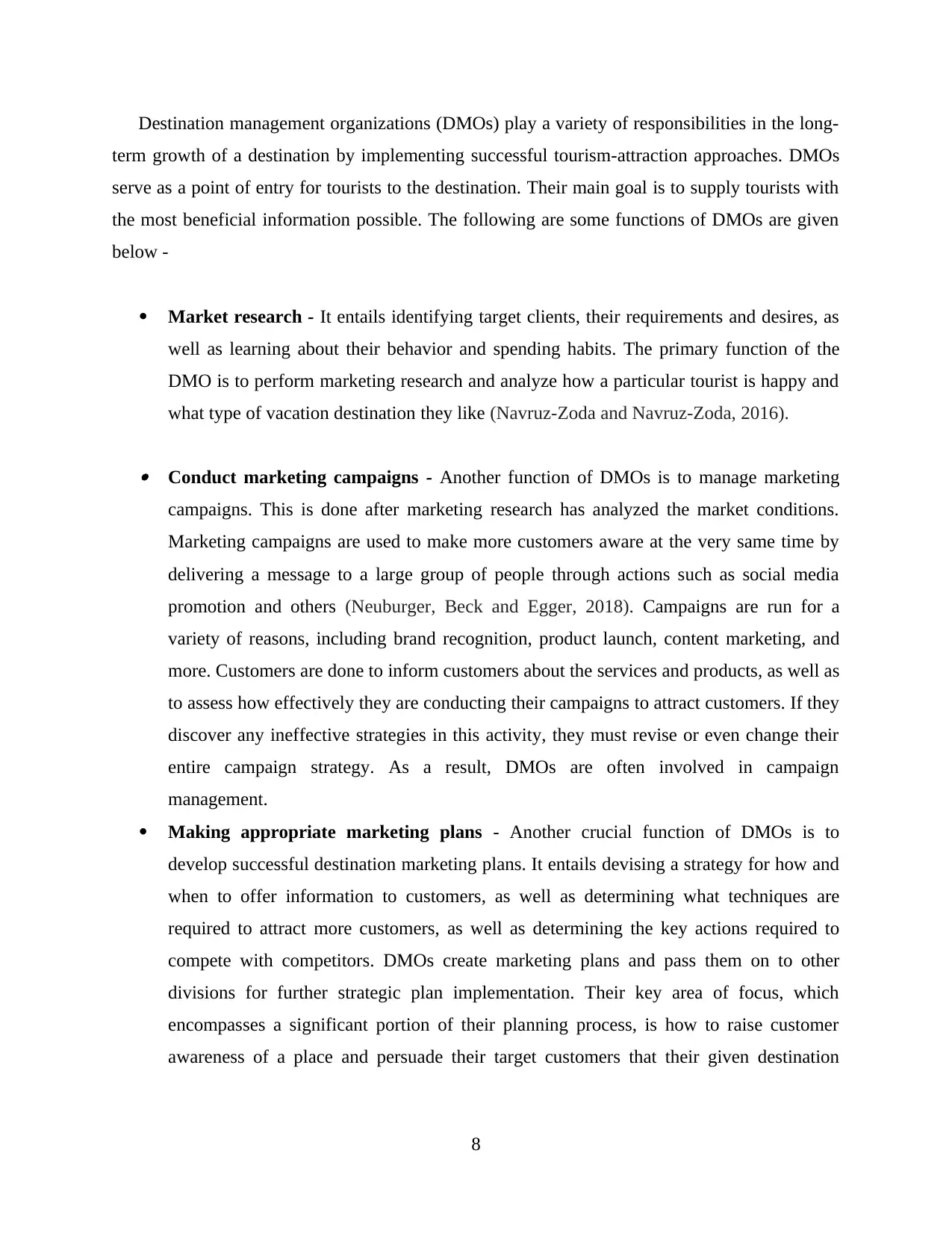
Destination management organizations (DMOs) play a variety of responsibilities in the long-
term growth of a destination by implementing successful tourism-attraction approaches. DMOs
serve as a point of entry for tourists to the destination. Their main goal is to supply tourists with
the most beneficial information possible. The following are some functions of DMOs are given
below -
Market research - It entails identifying target clients, their requirements and desires, as
well as learning about their behavior and spending habits. The primary function of the
DMO is to perform marketing research and analyze how a particular tourist is happy and
what type of vacation destination they like (Navruz-Zoda and Navruz-Zoda, 2016).
Conduct marketing campaigns - Another function of DMOs is to manage marketing
campaigns. This is done after marketing research has analyzed the market conditions.
Marketing campaigns are used to make more customers aware at the very same time by
delivering a message to a large group of people through actions such as social media
promotion and others (Neuburger, Beck and Egger, 2018). Campaigns are run for a
variety of reasons, including brand recognition, product launch, content marketing, and
more. Customers are done to inform customers about the services and products, as well as
to assess how effectively they are conducting their campaigns to attract customers. If they
discover any ineffective strategies in this activity, they must revise or even change their
entire campaign strategy. As a result, DMOs are often involved in campaign
management.
Making appropriate marketing plans - Another crucial function of DMOs is to
develop successful destination marketing plans. It entails devising a strategy for how and
when to offer information to customers, as well as determining what techniques are
required to attract more customers, as well as determining the key actions required to
compete with competitors. DMOs create marketing plans and pass them on to other
divisions for further strategic plan implementation. Their key area of focus, which
encompasses a significant portion of their planning process, is how to raise customer
awareness of a place and persuade their target customers that their given destination
8
term growth of a destination by implementing successful tourism-attraction approaches. DMOs
serve as a point of entry for tourists to the destination. Their main goal is to supply tourists with
the most beneficial information possible. The following are some functions of DMOs are given
below -
Market research - It entails identifying target clients, their requirements and desires, as
well as learning about their behavior and spending habits. The primary function of the
DMO is to perform marketing research and analyze how a particular tourist is happy and
what type of vacation destination they like (Navruz-Zoda and Navruz-Zoda, 2016).
Conduct marketing campaigns - Another function of DMOs is to manage marketing
campaigns. This is done after marketing research has analyzed the market conditions.
Marketing campaigns are used to make more customers aware at the very same time by
delivering a message to a large group of people through actions such as social media
promotion and others (Neuburger, Beck and Egger, 2018). Campaigns are run for a
variety of reasons, including brand recognition, product launch, content marketing, and
more. Customers are done to inform customers about the services and products, as well as
to assess how effectively they are conducting their campaigns to attract customers. If they
discover any ineffective strategies in this activity, they must revise or even change their
entire campaign strategy. As a result, DMOs are often involved in campaign
management.
Making appropriate marketing plans - Another crucial function of DMOs is to
develop successful destination marketing plans. It entails devising a strategy for how and
when to offer information to customers, as well as determining what techniques are
required to attract more customers, as well as determining the key actions required to
compete with competitors. DMOs create marketing plans and pass them on to other
divisions for further strategic plan implementation. Their key area of focus, which
encompasses a significant portion of their planning process, is how to raise customer
awareness of a place and persuade their target customers that their given destination
8
⊘ This is a preview!⊘
Do you want full access?
Subscribe today to unlock all pages.

Trusted by 1+ million students worldwide
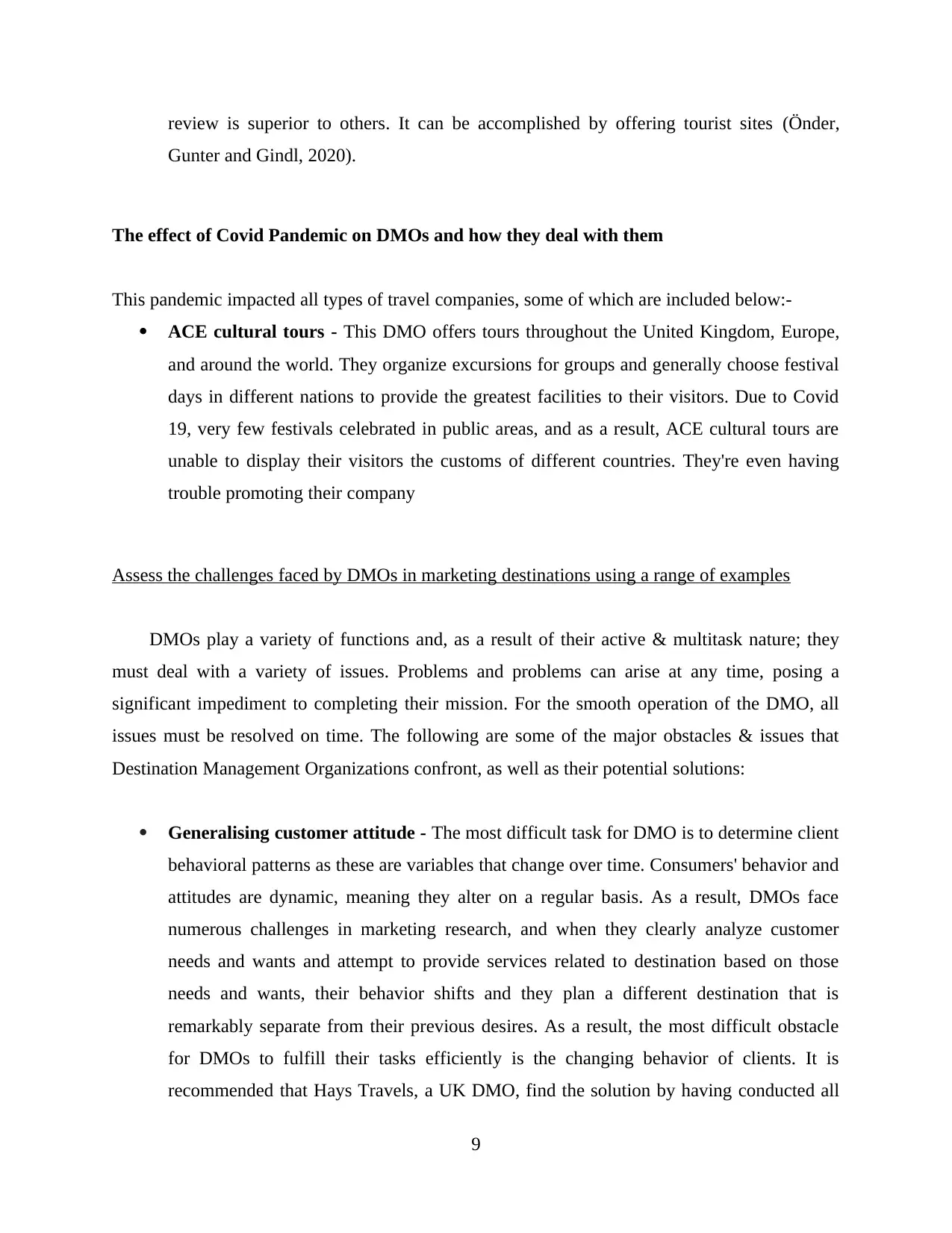
review is superior to others. It can be accomplished by offering tourist sites (Önder,
Gunter and Gindl, 2020).
The effect of Covid Pandemic on DMOs and how they deal with them
This pandemic impacted all types of travel companies, some of which are included below:-
ACE cultural tours - This DMO offers tours throughout the United Kingdom, Europe,
and around the world. They organize excursions for groups and generally choose festival
days in different nations to provide the greatest facilities to their visitors. Due to Covid
19, very few festivals celebrated in public areas, and as a result, ACE cultural tours are
unable to display their visitors the customs of different countries. They're even having
trouble promoting their company
Assess the challenges faced by DMOs in marketing destinations using a range of examples
DMOs play a variety of functions and, as a result of their active & multitask nature; they
must deal with a variety of issues. Problems and problems can arise at any time, posing a
significant impediment to completing their mission. For the smooth operation of the DMO, all
issues must be resolved on time. The following are some of the major obstacles & issues that
Destination Management Organizations confront, as well as their potential solutions:
Generalising customer attitude - The most difficult task for DMO is to determine client
behavioral patterns as these are variables that change over time. Consumers' behavior and
attitudes are dynamic, meaning they alter on a regular basis. As a result, DMOs face
numerous challenges in marketing research, and when they clearly analyze customer
needs and wants and attempt to provide services related to destination based on those
needs and wants, their behavior shifts and they plan a different destination that is
remarkably separate from their previous desires. As a result, the most difficult obstacle
for DMOs to fulfill their tasks efficiently is the changing behavior of clients. It is
recommended that Hays Travels, a UK DMO, find the solution by having conducted all
9
Gunter and Gindl, 2020).
The effect of Covid Pandemic on DMOs and how they deal with them
This pandemic impacted all types of travel companies, some of which are included below:-
ACE cultural tours - This DMO offers tours throughout the United Kingdom, Europe,
and around the world. They organize excursions for groups and generally choose festival
days in different nations to provide the greatest facilities to their visitors. Due to Covid
19, very few festivals celebrated in public areas, and as a result, ACE cultural tours are
unable to display their visitors the customs of different countries. They're even having
trouble promoting their company
Assess the challenges faced by DMOs in marketing destinations using a range of examples
DMOs play a variety of functions and, as a result of their active & multitask nature; they
must deal with a variety of issues. Problems and problems can arise at any time, posing a
significant impediment to completing their mission. For the smooth operation of the DMO, all
issues must be resolved on time. The following are some of the major obstacles & issues that
Destination Management Organizations confront, as well as their potential solutions:
Generalising customer attitude - The most difficult task for DMO is to determine client
behavioral patterns as these are variables that change over time. Consumers' behavior and
attitudes are dynamic, meaning they alter on a regular basis. As a result, DMOs face
numerous challenges in marketing research, and when they clearly analyze customer
needs and wants and attempt to provide services related to destination based on those
needs and wants, their behavior shifts and they plan a different destination that is
remarkably separate from their previous desires. As a result, the most difficult obstacle
for DMOs to fulfill their tasks efficiently is the changing behavior of clients. It is
recommended that Hays Travels, a UK DMO, find the solution by having conducted all
9
Paraphrase This Document
Need a fresh take? Get an instant paraphrase of this document with our AI Paraphraser
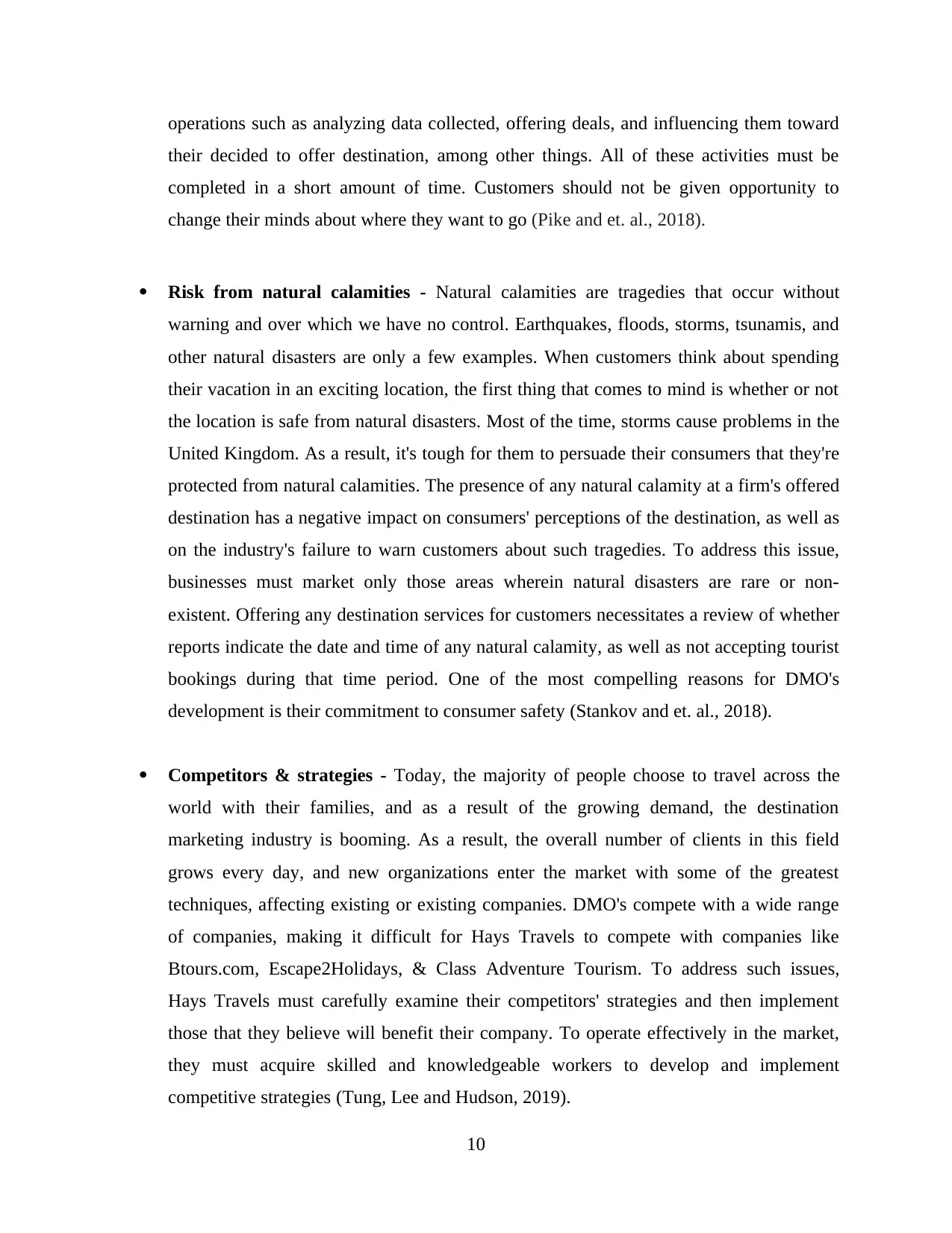
operations such as analyzing data collected, offering deals, and influencing them toward
their decided to offer destination, among other things. All of these activities must be
completed in a short amount of time. Customers should not be given opportunity to
change their minds about where they want to go (Pike and et. al., 2018).
Risk from natural calamities - Natural calamities are tragedies that occur without
warning and over which we have no control. Earthquakes, floods, storms, tsunamis, and
other natural disasters are only a few examples. When customers think about spending
their vacation in an exciting location, the first thing that comes to mind is whether or not
the location is safe from natural disasters. Most of the time, storms cause problems in the
United Kingdom. As a result, it's tough for them to persuade their consumers that they're
protected from natural calamities. The presence of any natural calamity at a firm's offered
destination has a negative impact on consumers' perceptions of the destination, as well as
on the industry's failure to warn customers about such tragedies. To address this issue,
businesses must market only those areas wherein natural disasters are rare or non-
existent. Offering any destination services for customers necessitates a review of whether
reports indicate the date and time of any natural calamity, as well as not accepting tourist
bookings during that time period. One of the most compelling reasons for DMO's
development is their commitment to consumer safety (Stankov and et. al., 2018).
Competitors & strategies - Today, the majority of people choose to travel across the
world with their families, and as a result of the growing demand, the destination
marketing industry is booming. As a result, the overall number of clients in this field
grows every day, and new organizations enter the market with some of the greatest
techniques, affecting existing or existing companies. DMO's compete with a wide range
of companies, making it difficult for Hays Travels to compete with companies like
Btours.com, Escape2Holidays, & Class Adventure Tourism. To address such issues,
Hays Travels must carefully examine their competitors' strategies and then implement
those that they believe will benefit their company. To operate effectively in the market,
they must acquire skilled and knowledgeable workers to develop and implement
competitive strategies (Tung, Lee and Hudson, 2019).
10
their decided to offer destination, among other things. All of these activities must be
completed in a short amount of time. Customers should not be given opportunity to
change their minds about where they want to go (Pike and et. al., 2018).
Risk from natural calamities - Natural calamities are tragedies that occur without
warning and over which we have no control. Earthquakes, floods, storms, tsunamis, and
other natural disasters are only a few examples. When customers think about spending
their vacation in an exciting location, the first thing that comes to mind is whether or not
the location is safe from natural disasters. Most of the time, storms cause problems in the
United Kingdom. As a result, it's tough for them to persuade their consumers that they're
protected from natural calamities. The presence of any natural calamity at a firm's offered
destination has a negative impact on consumers' perceptions of the destination, as well as
on the industry's failure to warn customers about such tragedies. To address this issue,
businesses must market only those areas wherein natural disasters are rare or non-
existent. Offering any destination services for customers necessitates a review of whether
reports indicate the date and time of any natural calamity, as well as not accepting tourist
bookings during that time period. One of the most compelling reasons for DMO's
development is their commitment to consumer safety (Stankov and et. al., 2018).
Competitors & strategies - Today, the majority of people choose to travel across the
world with their families, and as a result of the growing demand, the destination
marketing industry is booming. As a result, the overall number of clients in this field
grows every day, and new organizations enter the market with some of the greatest
techniques, affecting existing or existing companies. DMO's compete with a wide range
of companies, making it difficult for Hays Travels to compete with companies like
Btours.com, Escape2Holidays, & Class Adventure Tourism. To address such issues,
Hays Travels must carefully examine their competitors' strategies and then implement
those that they believe will benefit their company. To operate effectively in the market,
they must acquire skilled and knowledgeable workers to develop and implement
competitive strategies (Tung, Lee and Hudson, 2019).
10
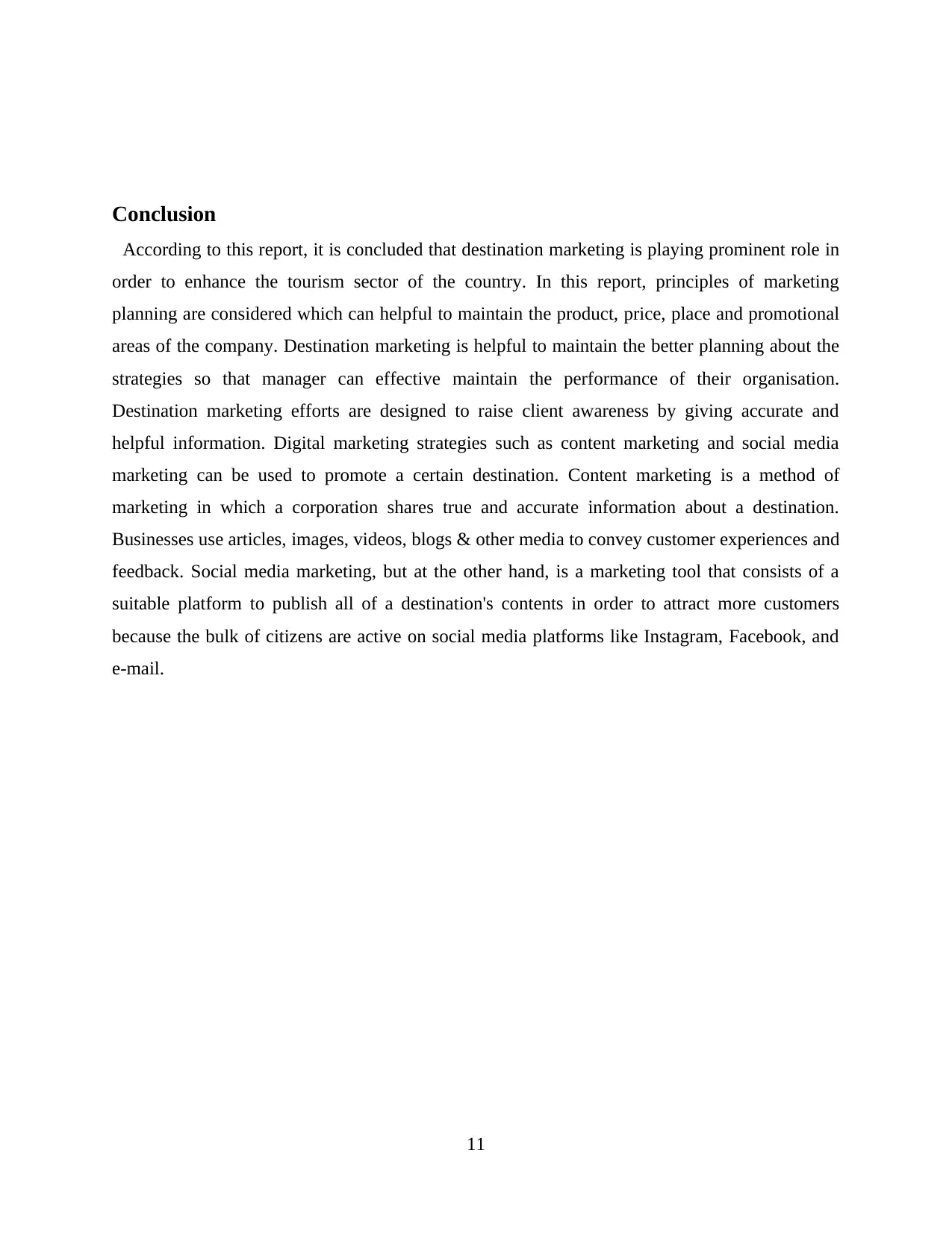
Conclusion
According to this report, it is concluded that destination marketing is playing prominent role in
order to enhance the tourism sector of the country. In this report, principles of marketing
planning are considered which can helpful to maintain the product, price, place and promotional
areas of the company. Destination marketing is helpful to maintain the better planning about the
strategies so that manager can effective maintain the performance of their organisation.
Destination marketing efforts are designed to raise client awareness by giving accurate and
helpful information. Digital marketing strategies such as content marketing and social media
marketing can be used to promote a certain destination. Content marketing is a method of
marketing in which a corporation shares true and accurate information about a destination.
Businesses use articles, images, videos, blogs & other media to convey customer experiences and
feedback. Social media marketing, but at the other hand, is a marketing tool that consists of a
suitable platform to publish all of a destination's contents in order to attract more customers
because the bulk of citizens are active on social media platforms like Instagram, Facebook, and
e-mail.
11
According to this report, it is concluded that destination marketing is playing prominent role in
order to enhance the tourism sector of the country. In this report, principles of marketing
planning are considered which can helpful to maintain the product, price, place and promotional
areas of the company. Destination marketing is helpful to maintain the better planning about the
strategies so that manager can effective maintain the performance of their organisation.
Destination marketing efforts are designed to raise client awareness by giving accurate and
helpful information. Digital marketing strategies such as content marketing and social media
marketing can be used to promote a certain destination. Content marketing is a method of
marketing in which a corporation shares true and accurate information about a destination.
Businesses use articles, images, videos, blogs & other media to convey customer experiences and
feedback. Social media marketing, but at the other hand, is a marketing tool that consists of a
suitable platform to publish all of a destination's contents in order to attract more customers
because the bulk of citizens are active on social media platforms like Instagram, Facebook, and
e-mail.
11
⊘ This is a preview!⊘
Do you want full access?
Subscribe today to unlock all pages.

Trusted by 1+ million students worldwide
1 out of 14
Related Documents
Your All-in-One AI-Powered Toolkit for Academic Success.
+13062052269
info@desklib.com
Available 24*7 on WhatsApp / Email
![[object Object]](/_next/static/media/star-bottom.7253800d.svg)
Unlock your academic potential
Copyright © 2020–2025 A2Z Services. All Rights Reserved. Developed and managed by ZUCOL.





